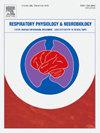Roflumilast, a phosphodiesterase-4 (PDE4) inhibitor, induces respiratory frequency plasticity that is resistant to inflammation in neonatal rat in vitro preparations
IF 1.6
4区 医学
Q3 PHYSIOLOGY
引用次数: 0
Abstract
Premature and newborn infants often have prolonged apneas and are susceptible to bacterial infections that further disrupt breathing. Phoshodiesterase-4 (PDE4) inhibitor drugs increase inspiratory motor activity and appear to induce a long-lasting increase in inspiratory frequency (“frequency plasticity”). To test whether a PDE4 inhibitor drug induces frequency plasticity, neonatal rat brainstem-spinal cords were isolated and exposed to bath-applied roflumilast (10 min, 0.02–1.0 µM). Roflumilast acutely increased burst frequency and induced frequency plasticity in a concentration-dependent manner. Blockade of protein kinase A (PKA) or exchange protein activated by cAMP (EPAC) signaling pathways abolished the induction, but not the maintenance, of roflumilast-induced frequency plasticity. Brainstem-spinal cords isolated from neonatal rats injected with lipopolysaccharide (LPS, 0.1 mg/kg, 3 h prior) expressed frequency plasticity following bath-applied roflumilast at 0.05–0.5 µM, but not at lower concentrations. This shows that roflumilast-induced frequency plasticity is largely resistant to LPS-induced inflammation. Thus, roflumilast increases inspiratory burst frequency acutely and induces frequency plasticity even during ongoing inflammation, which could have important clinical implications.
罗氟司特(一种磷酸二酯酶-4 (PDE4)抑制剂)可诱导新生大鼠体外制备的呼吸频率可塑性,这种可塑性对炎症具有抵抗力
早产儿和新生儿经常会出现长时间的呼吸暂停,并容易受到细菌感染,从而进一步影响呼吸。磷酸二酯酶-4(PDE4)抑制剂药物会增加吸气运动活动,似乎会诱导吸气频率的长期增加("频率可塑性")。为了测试 PDE4 抑制剂药物是否会诱导频率可塑性,我们分离了新生大鼠的脑干脊髓,并将其置于沐浴施用的罗氟司特(10 分钟,0.02-1.0 µM)中。罗氟司特能以浓度依赖性方式急性增加爆发频率并诱导频率可塑性。阻断蛋白激酶A(PKA)或cAMP激活的交换蛋白(EPAC)信号通路可消除罗氟司特诱导的频率可塑性的诱导,但不能维持这种可塑性。从注射了脂多糖(LPS,0.1 毫克/千克,3 小时前)的新生大鼠身上分离出的脑干脊髓在沐浴施用 0.05-0.5 µM 罗氟司特后表现出频率可塑性,但在较低浓度下则没有。这表明罗氟司特诱导的频率可塑性在很大程度上能抵抗 LPS 诱导的炎症。因此,罗氟司特能快速增加吸气爆发频率,即使在炎症持续期间也能诱导频率可塑性,这可能具有重要的临床意义。
本文章由计算机程序翻译,如有差异,请以英文原文为准。
求助全文
约1分钟内获得全文
求助全文
来源期刊
CiteScore
4.80
自引率
8.70%
发文量
104
审稿时长
54 days
期刊介绍:
Respiratory Physiology & Neurobiology (RESPNB) publishes original articles and invited reviews concerning physiology and pathophysiology of respiration in its broadest sense.
Although a special focus is on topics in neurobiology, high quality papers in respiratory molecular and cellular biology are also welcome, as are high-quality papers in traditional areas, such as:
-Mechanics of breathing-
Gas exchange and acid-base balance-
Respiration at rest and exercise-
Respiration in unusual conditions, like high or low pressure or changes of temperature, low ambient oxygen-
Embryonic and adult respiration-
Comparative respiratory physiology.
Papers on clinical aspects, original methods, as well as theoretical papers are also considered as long as they foster the understanding of respiratory physiology and pathophysiology.

 求助内容:
求助内容: 应助结果提醒方式:
应助结果提醒方式:


